In the vibrant underwater world of coral reefs, one small fish captures the imagination of both marine enthusiasts and casual observers alike—the clownfish. With their striking orange and white stripes and charismatic personalities, clownfish have become icons of the ocean’s splendor, famously immortalized in popular culture by the beloved character “Nemo” from Disney’s animated hit. But beyond their screen fame, these colorful fish play a crucial role in one of the most diverse and vital ecosystems on the planet.
Coral reefs, often referred to as the “rainforests of the sea,” are bustling underwater cities that provide shelter, food, and breeding grounds for countless marine species. These delicate ecosystems are not only a sanctuary for fish like the clownfish but also a key component in the health of the ocean. By supporting a rich tapestry of life and contributing to the overall balance of marine environments, coral reefs are indispensable to the health of our planet’s oceans. In this article, we’ll dive into the fascinating world of the clownfish, exploring their unique traits, behavior, and the vital role they play within their vibrant coral reef homes.
What is a Clownfish?
Clownfish, also known as anemonefish, are small, brightly colored marine fish belonging to the family Pomacentridae. These vibrant creatures are renowned for their distinctive orange and white striped patterns, though some species display variations in color and pattern. There are several species of clownfish, including the Ocellaris clownfish, often seen in home aquariums, and the Percula clownfish, which is similar but with subtle differences in coloration and size. Other notable species include the Clark’s clownfish and the Maroon clownfish, each with unique traits and adaptations suited to their specific environments.
Physical Appearance
Clownfish are easily recognizable due to their vivid coloration and bold stripe patterns. Most species sport a bright orange body adorned with white bands outlined in black, although variations in color can occur depending on the species and their environment. They are relatively small, with sizes ranging from about 4 to 5 inches in length, but some species can grow slightly larger. Clownfish exhibit various body shapes, from the more rounded Ocellaris clownfish to the more elongated Maroon clownfish. These physical traits not only make them visually appealing but also serve as adaptations to their coral reef habitats, where their colors can help in camouflage among the anemones.
Habitat and Distribution
Clownfish are predominantly found in the warm, shallow waters of the Pacific and Indian Oceans, where they thrive in the complex and diverse environment of coral reefs. These reefs offer a rich array of food sources and protection from predators, making them an ideal home for clownfish. Geographically, clownfish are distributed from the Red Sea and East Africa to the central Pacific Ocean, including regions around Australia, Indonesia, and the Philippines. Coral reefs are crucial to their survival, providing not only physical shelter but also a critical ecosystem that supports their diet and lifestyle.
Behavior and Lifestyle
Clownfish are highly social creatures that live in small, tight-knit groups known as “anemonefish families,” which are typically dominated by a breeding pair. These groups reside within the protective tentacles of sea anemones, which offer safety and a stable environment. Clownfish are omnivorous, feeding on a diet that includes algae, small crustaceans, and plankton. Their reproductive behavior is also noteworthy: clownfish exhibit a well-defined breeding cycle, with the dominant female laying eggs on a flat surface near their anemone home. The male then takes on the responsibility of guarding and caring for the eggs until they hatch.
The Symbiotic Relationship
The relationship between clownfish and sea anemones is a classic example of mutualism. Clownfish provide sea anemones with food scraps and protection from predators, while the anemones offer clownfish a safe haven from larger fish. To avoid the stinging cells of the anemones, clownfish have developed a unique layer of mucus on their skin that protects them from being harmed. This mutualistic bond enhances the survival and well-being of both species, showcasing a remarkable example of cooperation in the natural world.
Conservation Status
Despite their hardy appearance, clownfish face several threats due to human activities and environmental changes. Habitat destruction, primarily from coral reef degradation, and the impacts of climate change are significant concerns. Overfishing and the collection of clownfish for the aquarium trade also pose risks to their populations. Conservation efforts are underway to address these issues, including marine protected areas and sustainable aquarium practices. By supporting these initiatives and promoting reef conservation, individuals can help ensure the continued survival of clownfish and their coral reef habitats.
Fun Facts
Clownfish are more than just eye-catching; they also have fascinating characteristics and cultural significance. For instance, they are known to have a “gender-bending” system where the dominant female of a group is the only one to breed, and if she dies, the dominant male transitions to become the new female. Clownfish gained widespread fame through the animated film “Finding Nemo,” which brought their unique behaviors and vibrant colors to the attention of millions worldwide. This cultural representation has helped raise awareness about the importance of marine conservation.
Conclusion
Clownfish are not only a colorful and charismatic component of coral reef ecosystems but also a symbol of the intricate relationships that sustain marine biodiversity. Their vibrant presence underscores the importance of protecting coral reefs and the myriad of species that depend on them. By supporting conservation efforts and fostering a greater appreciation for these underwater marvels, we can help ensure that clownfish and their coral reef homes continue to thrive for generations to come.


